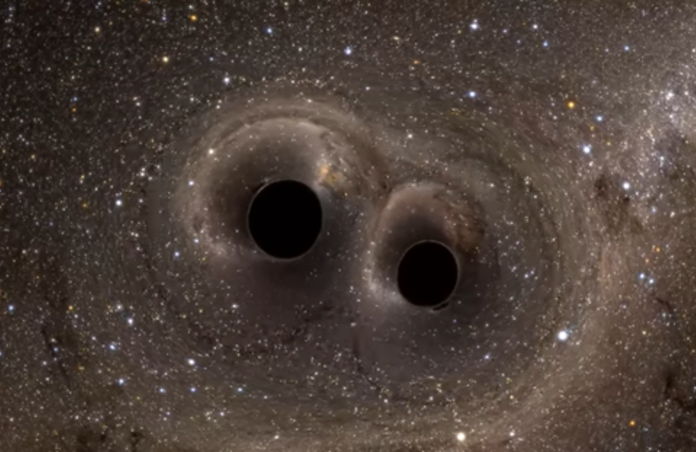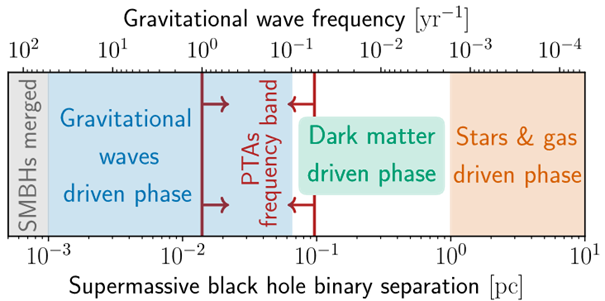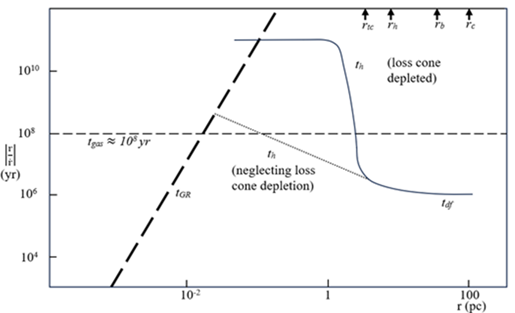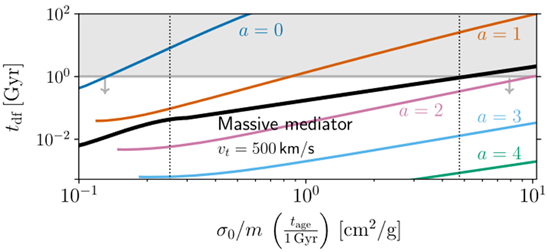Proposed Solution to the Black Hole ‘Final Parsec’ Problem

The final parsec problem is an astronomical puzzle involving the dynamical evolution of supermassive black holes (SMBHs) at the centres of most galaxies. Models suggest that when these black holes reach a separation of about one parsec, they begin to stall in their orbits. This issue was first highlighted in a 1980 paper by Mitchell Begelman et al., who studied the merging of SMBHs in active galactic nuclei.
The study explored two primary mechanisms by which orbiting black holes lose energy and draw closer: dynamical friction and gravitational wave emission. Dynamical friction, which occurs early in a galactic merger, involves smaller masses being ejected from stable orbits around the SMBHs, causing the black holes to move closer together. As they approach each other more closely, gravitational wave emission becomes the dominant process for energy loss.

However, at around a one-parsec separation, the SMBHs have expelled all the surrounding bodies that could contribute to further dynamical friction and are still too far apart for gravitational waves to play a significant role. This results in the black holes stalling at this distance, making it difficult for them to merge within the current age of the universe. In recent years, due to its increasing significance in other cosmological theories, this issue has been labelled as the 'final parsec' problem.

Now, a study led by Gonzalo Alonso-Álvarez attempts to address this problem using new models. The study is concerned with the recent discovery of a so-called gravitational wave background permeating the universe, believed to originate from countless pairs of SMBH binary mergers. Indeed, they propose that the mechanism by which these pairs could overcome the gap between dynamical friction and gravitational wave dominance can be found within dark matter (DM).
The study introduces an additional source of dynamical friction by considering a dark matter halo surrounding a The study introduces an additional source of dynamical friction by considering a dark matter halo surrounding a supermassive black hole (SMBH) binary. Under intense gravity, this halo forms a density spike of dark matter near the centre. However, if this process involves frictionless Cold Dark Matter (CDM), the dark matter particles are eventually ejected from orbit, much like baryonic matter. This disruption of the dark matter spike results in decreased efficiency of dynamical friction, causing the SMBH binary to stall.
Instead, they consider Self-Interacting Dark Matter (SIDM), which allows for non-gravitational interactions between dark matter particles, introducing internal friction within the dark matter halo. These interactions enable SIDM particles to redistribute kinetic energy through scattering processes, maintaining thermal equilibrium. As a result, the density of the dark matter spike remains high enough to continue providing significant dynamical friction, effectively allowing the black holes to overcome the final parsec problem. This mechanism enables the SMBH binary to reach separations of approximately 0.01–0.1 parsecs, where gravitational waves become the dominant force leading to merger. Models suggest that with SIDM, the black holes can overcome the final parsec problem within approximately one billion years.

This study presents far-reaching consequences in the field of cosmology, holding great significance in many areas of research. While the nature or even existence of dark matter remains a subject of active debate, its use of a less conventional form, such as SIDM, highlights the potential need for acceptance of niche interpretations beyond the widely accepted CDM paradigm. This mechanism likewise supports the hierarchical evolution of structure within our universe, bridging a gap between primordial ages and the present. The study positions itself as a preliminary exploration of the idea and suggests several avenues to advance this research, such as refining models of interaction cross-sections and conducting detailed numerical simulations to validate certain analytical calculations.
--
Journal Source: G. Alonso-Álvarez et al, Self-Interacting Dark Matter Solves the Final Parsec Problem of Supermassive Black Hole Mergers, Physical Review Letters, Vol 133, (2024), DOI: 10.1103/PhysRevLett.133.021401
Additional Sources: M. C. Begelman, Massive black hole binaries in active galactic nuclei, Nature, Vol 287, (1980), DOI: https://doi.org/10.1038/287307a0
Dr. Becky, The Final Parsec Problem: do SUPERMASSIVE black holes ever MERGE?, , YouTube, (2023), URL: https://www.youtube.com/watch?v=6tXIoViA_0g
Cover Image Credit: Simulating Extreme Spacetimes Project
